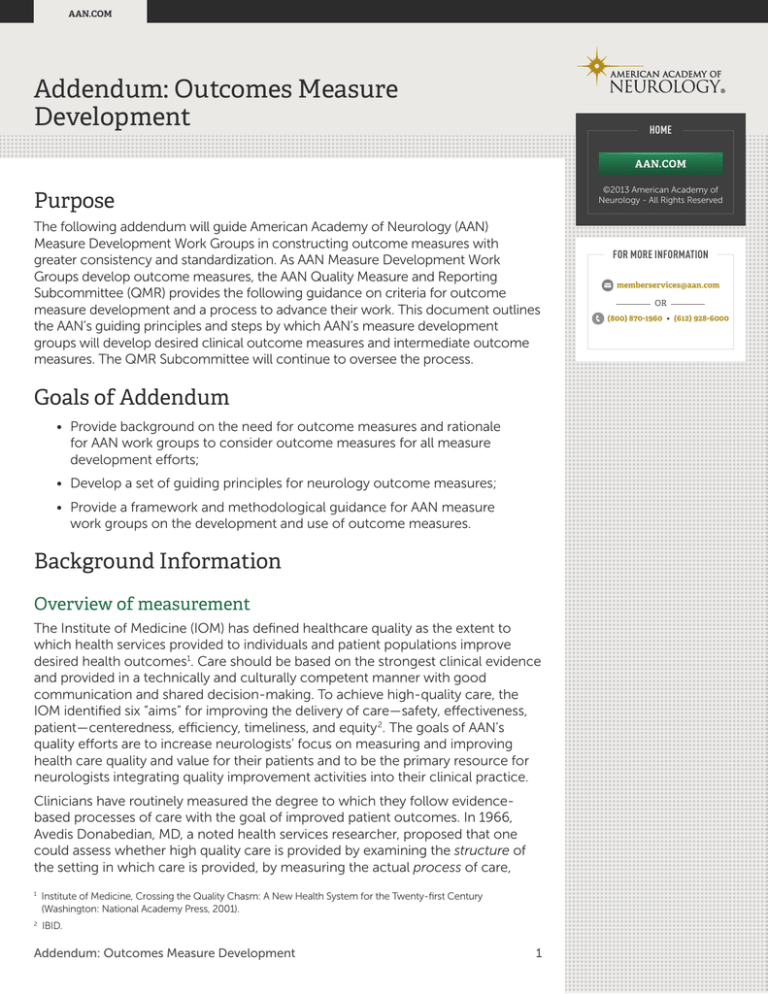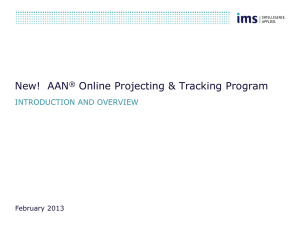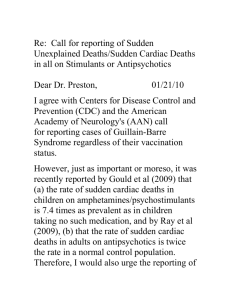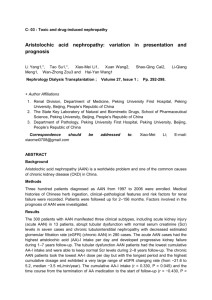
AAN.COM
Addendum: Outcomes Measure
Development
HOME
AAN.COM
Purpose
The following addendum will guide American Academy of Neurology (AAN)
Measure Development Work Groups in constructing outcome measures with
greater consistency and standardization. As AAN Measure Development Work
Groups develop outcome measures, the AAN Quality Measure and Reporting
Subcommittee (QMR) provides the following guidance on criteria for outcome
measure development and a process to advance their work. This document outlines
the AAN’s guiding principles and steps by which AAN’s measure development
groups will develop desired clinical outcome measures and intermediate outcome
measures. The QMR Subcommittee will continue to oversee the process.
Goals of Addendum
• Provide background on the need for outcome measures and rationale
for AAN work groups to consider outcome measures for all measure
development efforts;
• Develop a set of guiding principles for neurology outcome measures;
• Provide a framework and methodological guidance for AAN measure
work groups on the development and use of outcome measures.
Background Information
Overview of measurement
The Institute of Medicine (IOM) has defined healthcare quality as the extent to
which health services provided to individuals and patient populations improve
desired health outcomes1. Care should be based on the strongest clinical evidence
and provided in a technically and culturally competent manner with good
communication and shared decision-making. To achieve high-quality care, the
IOM identified six “aims” for improving the delivery of care—safety, effectiveness,
patient—centeredness, efficiency, timeliness, and equity 2. The goals of AAN’s
quality efforts are to increase neurologists’ focus on measuring and improving
health care quality and value for their patients and to be the primary resource for
neurologists integrating quality improvement activities into their clinical practice.
Clinicians have routinely measured the degree to which they follow evidencebased processes of care with the goal of improved patient outcomes. In 1966,
Avedis Donabedian, MD, a noted health services researcher, proposed that one
could assess whether high quality care is provided by examining the structure of
the setting in which care is provided, by measuring the actual process of care,
1
Institute of Medicine, Crossing the Quality Chasm: A New Health System for the Twenty-first Century
(Washington: National Academy Press, 2001).
2
IBID.
Addendum: Outcomes Measure Development1
©2013 American Academy of
Neurology - All Rights Reserved
FOR MORE INFORMATION
memberservices@aan.com
OR (800) 870-1960 • (612) 928-6000
AAN.COM
and by assessing what are the outcomes of the health care service provided.
Donabedian noted that when coupled with structure and process measures,
outcomes measures provide useful and actionable information for physicians on
the quality of care—if they are causally related—“structure leads to process and
process leads to outcomes” 3.
With increasing emphasis on accountable, transparent, and patient-focused care,
health care quality measurement efforts are shifting from measuring a process, or
series of processes, to measuring whether a patient achieved the desired health
outcomes. Donabedian defined outcomes as “changes (desirable or undesirable)
in individuals and populations that are attributed to health care services received” 4.
Outcomes measurement in health care is not new 5. Individual clinicians have used
biomedical measures, such as the results of laboratory tests, to determine whether
a health intervention is necessary or successful. What is new to clinical practice
are the emerging domains of outcomes measurement for which physicians are
held accountable6. While the field of outcomes measurement is not fully mature7,
health care is testing and implementing several types of outcome measures.
Types of measures
• Desired clinical outcome measures: Desired clinical outcome measures
assess the long-term result of a patient’s interaction with health care
system. Many neurological conditions are very complex and difficult to
measure. In these cases, proxy measures are ways to measure what you
can when you can’t measure exactly what you want or need to. Example:
it may be difficult to access data in a medical record about a practice’s
effectiveness in counseling for smoking cessation. Instead the proxy
measure might be how many patients had “tobacco abuse” coded as
a diagnosis and how many of those patients received prescriptions for
Zyban or nicotine replacement.
• Intermediate outcomes: Intermediate outcomes precede and are closely
related to a longer-range desired outcome. Often intermediate outcome
measures are physiological or biochemical values. These measures often
specify thresholds or other results of clinical care that are shown to affect
the desired health outcome positively or adversely. The disease process
of many neurological conditions can be very slow, often taking decades
for a desired clinical outcome to manifest. In these cases, an intermediate
outcome measure might be more appropriate. Example: blood pressure
maintained at 120/80 or less, glycemic control at <8, and cholesterol
level<180 are intermediate outcome measures on the trajectory to reduced
complications in diabetic patients.
3
Donabedian A. The role of outcomes in quality assessment and assurance. QRB Qual Rev Bull. 1992;18:356–360.
4
Donabedian A, The quality of care. How can it be assessed? JAMA, 1988;260(12):1743-1748.
5
ampazzi, EJ., & Lee, D.A. (1995). Quality is in the eye of the beholder, Patient Satisfaction & Outcomes
C
Management in Physician Practices. American Health Consultants, 1 ( 3), 33-36.
6
ational Quality Forum, Guidance for Evaluating the Evidence Related to the Focus of Quality Measurement. 2010
N
Available at: http://www.qualityforum.org/Measuring_Performance/Improving_NQF_Process/Evidence_Task_
Force.aspx Accessed 2.01.2013
7
Campazzi, EJ., & Lee, D.A. (1995). Quality is in the eye of the beholder, Patient Satisfaction & Outcomes
Management in Physician Practices. American Health Consultants, 1 ( 3), 33-36.
Addendum: Outcomes Measure Development2
HOME
AAN.COM
©2013 American Academy of
Neurology - All Rights Reserved
FOR MORE INFORMATION
memberservices@aan.com
OR (800) 870-1960 • (612) 928-6000
AAN.COM
• Patient reported outcome (PROs) measures: Patient reported outcomes
measures are defined as “any report of the status of a patient’s health
condition that comes directly from the patient, without interpretation of
the patient’s response by a clinician or anyone else8.” PROs can provide
important insights for providers into the way patients perceive their health
and the impact that treatments have on their quality of life9, 10. PROs assess
from the patient’s perspective:
• Health related quality of life: Quality of Life assessments (QOLs) seek to
evaluate how a treatment or disease affects a patient psychologically,
socially, and physically. QOLs can identify specific healthcare needs,
provide evidence that can lead to improved quality of care, and provide
a rapid screening test to identify populations or individuals who might
need a more detailed health needs assessment. Example: in patients
with Multiple Sclerosis, PRO measures such as the Expanded Disability
Status Scale or the Multiple Sclerosis Quality of Life-54 (MSQoL-54)
assess the impact of illnesses on their day-to-day lives.
• Patient experience with care: Patient experience reflects the interaction
between an organization and a patient as perceived through the
patient’s lens. Patient experience refers to the quality and value of all
of the interactions—direct and indirect, clinical and non-clinical—
spanning the entire duration of the patient/provider relationship.
Example: the Consumer Assessment of Healthcare Providers and
Systems (CAHPS) suite of surveys assesses patient perceptions in
a variety of domains including timeliness of care, interactions with
clinicians and office staff, and shared decision-making and patient
engagement.
• Economic Outcomes: Economic outcomes include measures of health
resource utilization and typically represent the payer and societal
perspective. Cost measures usually describe the total costs of care for a
particular population, the relative cost effectiveness of treatments, and
provider resource use.
• Adverse outcomes: Adverse events are serious complications caused
by medical treatment, devices, or medical advice. Examples of adverse
outcomes include rates of Wrong Site Procedures, Wrong Side Procedures,
Procedures on the Wrong Patient, Wrong Procedures, and Wrong Implants.
• Morbidity and mortality: Historically, most of the efforts to monitor and/
or report outcomes have focused on morbidity or mortality. Indicators
of morbidity, often indicative of the health of a community, include the
prevalence of chronic diseases or disabilities. Mortality rates and ratios
measure patient deaths associated with health care services.
8
U.S. FOOD AND DRUG ADMINISTRATION. Guidance for Industry.Patient-Reported Outcome Measures:
Use in Medical Product Development to Support Labeling Claims. Federal Register 2009;74(35):65132-133.
9
IBID.
10
Fung CH, Hays RD. Prospects and challenges in using patient-reported outcomes in clinical practice.
Quality of Life Research. 2008; 17: 1297-302.
Addendum: Outcomes Measure Development3
HOME
AAN.COM
©2013 American Academy of
Neurology - All Rights Reserved
FOR MORE INFORMATION
memberservices@aan.com
OR (800) 870-1960 • (612) 928-6000
AAN.COM
Measurement definitions
Clinical quality measures include a numerator, a denominator and indicate if there
are any exclusions for the measure.
• Numerator: The numerator is the count who received the treatment or
achieved the outcome out of those who were in the denominator.
• Denominator: The denominator is the “universe” of who is eligible to receive
the treatment or achieve the outcome.
• Exclusions: Denominator exclusions are a patient characteristic that allows
removal of that patient from the previously defined patient cohort. A
numerator exclusion represents patient characteristics that indicate reasons
individual patients should not receive the interventions (e.g., medications,
procedures) expected in the numerator (e.g., a patient with allergy or serious
adverse reaction to an expected medication).
• Calculation: Numerator: (# of patients meeting numerator criteria)
Divided by
Denominator: (# patients in denominator) – (# patients with valid
denominator exclusions)
Drivers for outcome measurement
Increasingly purchasers, payers, government agencies, and patients are requiring
that health care providers demonstrate the quality of the care they provide. This
immediate national focus on outcomes is placing demands on medical specialty
societies to develop outcomes measures rapidly that meaningfully and accurately
demonstrate high-quality patient outcomes.
Drivers for outcomes measures include:
• Public and private purchasers of health care expect providers to show how
their investments are realizing positive health outcomes.
• Payers are developing payment models that focus on accountability for
improved outcomes and lower costs; and providing financial incentives to
providers that achieve these aims.
• Providers use measures of health outcomes assess the effectiveness of
treatments and make improvements to care.
• Patients use outcome measures to select high-quality providers.
Linking process, intermediate outcomes, and desired outcomes
As noted above, Donabedian specified that a causal relationship must exist
between structure, process, and outcome11. In addition, outcomes measures
should be based on the evidence and the links to structure and process should
be evidence-based. The figures below illustrate the link from a process to
desired clinical outcome measure and an example of the link between process,
intermediate outcomes and desired clinical outcomes for multiple sclerosis.
11 Donabedian A. The role of outcomes in quality assessment and assurance. QRB Qual Rev Bull. 1992;18:356–360.
Addendum: Outcomes Measure Development4
HOME
AAN.COM
©2013 American Academy of
Neurology - All Rights Reserved
FOR MORE INFORMATION
memberservices@aan.com
OR (800) 870-1960 • (612) 928-6000
AAN.COM
Process
What are the
evidence-based
interventions, services,
processes, and/or
actions that are an
intentional part of
care and bring about
the intended changes
or outcomes?
Intermediate
Outcome
Desired Clinical
Outcome
What are the biological
and/or physiological
changes in patients’
clinical status, level
of functioning, that
indicate improvements
to or worsening of the
disease?
What are the changes
in the course of a
disease or procedure
(intended or
unintended)?
Documentation
of offer of
psychosocial support
AAN.COM
©2013 American Academy of
Neurology - All Rights Reserved
FOR MORE INFORMATION
Example in the treatment of patients with Multiple Sclerosis (M.S.):
Process
HOME
Intermediate
Outcome
Desired Clinical
Outcome
• MSQoL-54 Score
• Physical functional
status
• Mental functional
status
• Disability (Days
missed from work)
• Improvements
to Health-related
QOL
Figure 1: Link from process to intermediate to desired clinical outcome
Developing Desired Clinical Outcomes Measures
and Intermediate Measures
Over the past seven years, the AAN has successfully developed several quality
measure sets. The AAN’s measures primarily assess implementation of evidencebased processes and have been used to improve quality, advance professional
certification programs, and have been considered for public payer incentive programs.
As health care quality measurement advances towards outcomes measurement
so too must the AAN’s quality measure development efforts. AAN Measure
Development Work Groups (“work groups”) will continue to develop quality
measures sets using the process outlined in the full 2010 AAN Measure
Development Process Manual. However, future work groups will develop process
measures for quality improvement and seek to include desired clinical outcome
measures, intermediate outcome measures, and/or patient-reported outcome
measures in each measure set.
This document identifies guiding principles for outcome measures in neurology
and provides a guiding framework for AAN work groups as they develop
outcome measures.
Addendum: Outcomes Measure Development5
memberservices@aan.com
OR (800) 870-1960 • (612) 928-6000
AAN.COM
Guiding Principles for AAN Desired Clinical Outcome Measures
• Outcome measures must be clinically relevant, meaningful, measureable,
and actionable by the clinician.
• If assessing desired outcomes are impractical due to feasibility, data
collection, availability of longitudinal data, and/or patient tracking then AAN
work groups should begin with intermediate clinical outcomes measures12.
• Measure development work groups should distinguish between outcome
measures that are around a defined episode (i.e., stroke), around a chronic
condition (i.e., epilepsy), or around a deteriorating condition (i.e., dementia).
Initially outcome measures will be developed around a clinical disease entity
(e.g., Parkinson’s disease) or episode of care (e.g., stroke), rather than across
multiple diseases13.
• Selecting desired clinical outcome must be based on a critical evaluation of
the evidence base. QMR acknowledges that the evidence to support past
quality measure development was rooted in AAN clinical practice guidelines.
However, for outcomes measures there may be limited evidence and
therefore a limited linkage between outcome measures and AAN’s clinical
practice guideline recommendations.
• There must be evidence supporting specific patient outcomes and those
must be the result of patients’ interactions with the health care system.
• The evidence must indicate with a high-level of confidence that the
chosen outcome is appropriate for the disease and is the best measure
for the disease.
• There must be a body of evidence providing a link between the
intermediate outcome measure or the desired clinical outcome
measure and a process of care14.
• AAN desired clinical outcome and intermediate measures must be fully
specified, including15:
• A statement of the desired patient outcome;
• The patient population and any exceptions to the population
(denominator);
• The definition of those who achieved the desired outcome
(numerator);
• Measure exceptions;
• The measurement time window;
• The frequency that the outcome measure should be calculated;
• The level of measurement;
12
IBID.
13
E
xcerpted from: American Medical Association Physician’s Consortium for Performance Improvement.
Measures Development, Methodology, and Oversight
Advisory Committee: Recommendations to PCPI Work Groups on Outcome Measures. (August, 2011).
Accessed via the World Wide Web on December 12, 2012 at www.ama-assn.org.
14
IBID.
15
IBID.
Addendum: Outcomes Measure Development6
HOME
AAN.COM
©2013 American Academy of
Neurology - All Rights Reserved
FOR MORE INFORMATION
memberservices@aan.com
OR (800) 870-1960 • (612) 928-6000
AAN.COM
• Provider responsible for the patient outcome: Outcome measures
may be attributed to individual clinicians, teams of care or systems of
care. However, ideally, the primary accountability should be with the
ordering clinician who understands the clinical scenario best 16; and
• Data source: Measure specifications should clearly state from what
data sources the measure components are derived (e.g., administrative
data, chart abstraction, electronic health record) 17. Clinicians must
be able to collect data for the measure. The data should be timely
and must not create significant administrative or financial burden to
practices. Feedback should be meaningful and ongoing. Data sources
must not violate any standards of patient confidentiality.
• AAN desired clinical outcome and intermediate measures must be
statistically sound. Measures must have the statistical power to detect
variation in quality at the level of care for which they were developed.
Measures must be:
• Valid—they must assesses what them measure is intended to.
• Reliable—they must be repeatable across settings, raters, and patient
populations.
• Responsive—they must detect clinically meaningful changes in patients
over time and remains stable when there is no change.
• Risk adjustment methodologies used will be unique to each measure set,
depending on the type of measure (e.g., mortality, symptoms, or adverse
events)18. The denominator should incorporate dimensions of risk for the
outcome, where applicable19 and must not lead to gaming or affect patient
access to neurological care. To alleviate data burden, AAN measures should
seek to avoid complex risk adjustment methodologies20.
Step 1: Define the desired outcome(s) for the patient population
Neurology is a specialty of chronic and/or recurrent, incurable, or lethal
disease. Due to the persistence and progression of some neurological diseases,
measures should allow for outcomes on a continuum that includes cure, relief
from disease-related symptoms, slower deterioration, prolongation of survival,
and palliative care.
Work groups should define the desired clinical outcomes for the patient
population and identify what interventions and services will lead to improved
outcomes. Working from the desired outcome, work groups will then define the
evidence-based intermediate outcomes and the evidence-based processes that
lead to those outcomes. To guide the conversation, the work groups might ask the
following questions:
16
IBID.
17
IBID.
18
IBID.
19
IBID.
20
IBID.
Addendum: Outcomes Measure Development7
HOME
AAN.COM
©2013 American Academy of
Neurology - All Rights Reserved
FOR MORE INFORMATION
memberservices@aan.com
OR (800) 870-1960 • (612) 928-6000
AAN.COM
• What is the highest level of desired outcome that a particular patient
population might achieve?
• How can this be stated as a desired clinical outcome?
• Thinking of the typical trajectory of a disease and a patient populations’
response to treatment or non-treatment, what are the inflection points,
clinical decision points, or clinical indicators that illustrate quality
outcomes?
• How might these help to identify potential intermediate outcomes
measures?
• What services, processes, or interventions will need to be in place to help
patients achieve the outcome?
• How can the process(es) be measured?
• What is the intended use of the clinical measure? What decisions will
clinicians, patients, and/or other stakeholders need to make?
Step 2: Review the Evidence21
Outcome quality measures must be the result of a critical evaluation of the
evidence. Some diseases or conditions have very well defined evidencebased guidelines, while other conditions have a smaller evidence base. Ideally,
prior to establishing a work group the QMR Subcommittee will base their
prioritization and selection of clinical areas for measure development on the
availability of scientific literature supporting specific processes of care and
desired clinical outcomes.
The work group will review the evidence for care processes, intermediate
outcomes, and desired outcomes for a given condition. This includes evidence
that the chosen outcome is appropriate, that it is the best measure for the
disease or condition in question, and there is explicit evidence that the specific
care process will lead to changes in clinical outcome.
National Quality Forum’s (NQF) provides guidance on the evidence
needed to support intermediate and desired clinical outcomes
measurement (Table 1).
21
The AAN’s evidence-base policy outlines the evidence requirements for measure development. Going forward
this policy may need to accommodate different approaches to measure development and the evidence that
is required for outcome measures. QMR recognizes there are some neurologic conditions for which there is
not a high level of evidence either for processes of care, intermediate outcomes, or desired clinical outcomes.
In these cases, the outcome measure should be based on the strongest evidence possible and work groups
must provide a justification for the minimal link between proposed outcome measures and clinical guideline
recommendations.
Addendum: Outcomes Measure Development8
HOME
AAN.COM
©2013 American Academy of
Neurology - All Rights Reserved
FOR MORE INFORMATION
memberservices@aan.com
OR (800) 870-1960 • (612) 928-6000
AAN.COM
Table 1: Evidence Needed to Support Outcome Measurement22
Definition
Level of evidence
Example
Desired Clinical Health
Outcome An outcome
of care is a health state
of a patient (or change
in health status) resulting
from healthcare –
desirable or adverse.
Optimally, quantity,
quality, and consistency
for a body of evidence
that the measured
outcome (desirable or
adverse) is influenced by
at least one healthcare
process or service.
However, outcomes do
not necessarily require
evidence.
Mortality, Morbidity,
Symptoms, Clinical
Events
Intermediate Outcome
An intermediate outcome
is a change in physiologic
state that leads to a
longer-term health
outcome.
Quantity, quality, and
consistency of a body
of evidence that the
measured intermediate
clinical outcome leads to
desired health outcomes
in the target population.
Blood pressure levels,
blood glucose levels
Patient Reported
Outcomes23
Characteristics for
selecting PROS:
Conceptual and
measurement
model, reliability,
internal consistency,
reproducibility,
validity, content
validity, construct
and criterion related
validity, responsiveness,
interpretability of
scores, burden, and
alternative methods of
administration.
Quality of life- health
status as perceived by the
individual;
Patient experience
with care; knowledge,
understanding,
motivation; health
risk status or behavior
(including adherence);
patient satisfaction or
experience with care.
Generally, there is a
limited evidence-base
supporting patient
experience of care and
functional status.
Acute Myocardial
Infarction 30-day
Mortality, Oxford Knee
score
HOME
AAN.COM
©2013 American Academy of
Neurology - All Rights Reserved
FOR MORE INFORMATION
memberservices@aan.com
OR (800) 870-1960 • (612) 928-6000
Hemoglobin A1c
Management
Functional measuresSF-36, PROMIS ; Pre- and
post- treatment physical
function; other measures
of health status such as
pain, vitality, perceived
well-being, health risk
status, etc.
Patient Experience
with Care:
Consumer assessment
of healthcare Providers
and Systems (CAHPS);
shared decision
making; engagement
of family and friends;
patient knowledge and
understanding.
22
N
ational Quality Forum, Guidance for Evaluating the Evidence Related to the Focus of Quality Measurement.
2010 Available at: http://www.qualityforum.org/Measuring_Performance/Improving_NQF_Process/Evidence_
Task_Force.aspx Accessed 2.01.2013
23
T
he AAN has added an additional row to address the evidence required for patient reported outcomes.
Addendum: Outcomes Measure Development9
AAN.COM
Step 3: Identify the link between outcomes and regular processes of care
The work group should demonstrate through supporting evidence that
there is a proximal link between the process of care and the desired clinical
or intermediate outcome and that process of care is modifiable by health
care providers through intervention24. This means that the desired clinical
or intermediate outcome relates directly to a specific process or clinical
intervention and there is evidence of a causal relationship between the process
and the desired clinical or intermediate outcome.
Process
Assessment
Diagnosis
Recommendation
Outcome
Intermediate Outcome
Health/Clinical Outcome
Patient Reported Outcome
Intervention
Step 4: Define the type of outcome measure
Based upon the evidence supporting the desired clinical and intermediate
outcome(s) for a patient population, work groups will determine what type of
outcome measure is most appropriate to develop. Possible types of outcomes
measures include:
Type of Outcome Measure
Example
Clinical Outcomes
Mortality
Post-surgery death rates
Morbidity
Reduce rates of gestational diabetes
Intermediate clinical outcomes
Blood glucose levels
Symptoms
Reduction in pain
Clinical events
Stroke
Patient-Reported Outcomes
Health Status
PROMIS
Patient experience with care
CG-CAHPS
Economic Outcomes
Resource Use/Costs
Cost per episode of care
Table 2: Types of outcome measures25
24
E
xcerpted from: American Medical Association Physician’s Consortium for Performance Improvement.
Measures Development, Methodology, and Oversight Advisory Committee: Recommendations to PCPI Work
Groups on Outcome Measures. (August, 2011). Accessed via the World Wide Web on December 12, 2012 at
www.physicianconsortium.org.
25
IBID.
Addendum: Outcomes Measure Development10
HOME
AAN.COM
©2013 American Academy of
Neurology - All Rights Reserved
FOR MORE INFORMATION
memberservices@aan.com
OR (800) 870-1960 • (612) 928-6000
AAN.COM
Step 5: Develop the candidate measure statements for the topic
After the work group identifies the desired clinical outcomes, intermediate
outcomes, and process of care and links them to the evidence, the work
group will draft candidate measures that define the measurement statement
(i.e., numerator, denominator, exceptions, etc.). The work group should
consider existing measures for a given condition. Measure specifications must
be “harmonized” with other measures. Measure harmonization refers to the
standardization of measure specifications and definitions so that they are uniform
or compatible, including numerator, denominator, exclusions, data source,
and data collection instructions. The extent of harmonization depends on the
relationship of the measures, the evidence for the specific measure focus, and
differences in data sources.
The work group will precisely specify measures components considering the
following criteria:
Specify the denominator
What is the eligible patient population for this measure that could benefit
from the intervention?
Inclusion criteria: Denominator inclusion: diagnosis, diagnostic subgroup, acuity
of diagnosis, age ranges, and other positive selection factors.
Exception criteria Denominator exceptions: medical, patient, or system causes
that would remove a patient from the denominator if the numerator criteria
cannot be met. Exceptions should be specific, applicable, and documented
and should only include medical reasons (e.g., drug sensitivities, complicating
co-morbid conditions), patient reasons (e.g., patient religious preference), and
system reasons (e.g., imaging equipment not available, no insurance coverage
for procedure).
Specify the numerator
Which patients demonstrate the desired outcome? What must the clinician do
to show they completed the measure?
The numerator should reflect the clinical recommendation statements from the
referenced clinical guidelines and/or other evidence that served as the basis for
the measure.
Time window: What is the timeframe during which the patient population is
expected to benefit from the intervention or to show the considered outcome?
Often, the optimal duration can be difficult to assess when some outcomes
manifest over long periods, such as the delay of or preventing worsening of a
degenerative chronic disease. In these cases, the work group should identify
key decision points or clinical inflection points of response to treatment or
non-treatment and determine how these points might help to identify potential
intermediate outcomes measures.
Attribution: To which provider is the desired or intermediate clinical outcome
attributed? Most patients with neurologic conditions receive care from multiple
clinicians. The work group should consider the appropriate level of accountability
by assessing the decision-making responsibilities and utilization for a specific
set of services for a given measure concept. This will also help the work group
determine the level of measurement
Addendum: Outcomes Measure Development11
HOME
AAN.COM
©2013 American Academy of
Neurology - All Rights Reserved
FOR MORE INFORMATION
memberservices@aan.com
OR (800) 870-1960 • (612) 928-6000
AAN.COM
Determine the level of measurement
What level of the health care system is accountable for the outcome?
What changes to the outcome are in their control?
The level of measurement should include the level of accountability (e.g., individual,
team, clinic, in-hospital caregivers, or noninvasive or procedural laboratory) and
the lowest level of meaningful data collection. Neurology is often a specialty where
practices and/or individual physicians see small numbers of patients with a given
condition and one would need a very large sample to detect differences in the
quality of care from neurologist-to-neurologist. The work group should ensure the
level of measurement and the unit of surveillance results in valid data.
HOME
AAN.COM
©2013 American Academy of
Neurology - All Rights Reserved
FOR MORE INFORMATION
Classify risk adjustment variables and/or risk stratification methods:
Consider how risk would be addressed when writing the measures. Conducting
multivariate modeling and regression analysis of risk variables for their relative
impact on selected outcomes is time consuming and requires extensive resources.
• Ask whether risk adjustment is necessary. The answer to this question
is complex and requires expert opinion from both clinical and
epidemiological perspectives.
• Identify the variables or the “dimensions of risk” that will affect the outcome
of interest and then devise a risk strategy to address these variables.
• Recommend a model or strategy
• Risk stratification: Quality of care is assessed independently of patient
case-mix. Risk stratification evaluates each patient’s current health
status and morbidity burden, comparing this to the average of the
population as a whole and stratifying the population into groups who
have similar levels of healthcare requirements. Factors such as race,
ethnicity, and socioeconomic status can be used for risk stratification.
It is preferable to stratify measures by race and socioeconomic status
rather than to adjust out the differences. If a measure is stratified by a
particular factor, it cannot then be used as a risk adjustment variable.
Example: Comparison of mammography rates between Caucasian
women and African- American women.
• Risk adjustment: Controls for the potential influence of patient
characteristics that are generally not under the control of clinicians
that can affect outcomes. The purpose is to “make the playing field
level” across settings and sites. So as not to mask disparities in care,
factors such as race, ethnicity, and socioeconomic status should not be
included in risk adjustment models. Example: The impact of a patient’s
age on surgical outcomes.
• Identify a list of risk predictive variables for the outcome of interest.
Bear in mind that most risk models rely on readily available
administrative data that can be used to assess risk factors relating
to the patient’s diagnoses, surgical procedures, age, gender, and
complications and comorbidities.
Addendum: Outcomes Measure Development12
memberservices@aan.com
OR (800) 870-1960 • (612) 928-6000
AAN.COM
• Recommend the use of off-the-shelf methods that are readily available
in existing software programs. Major risk adjustment developers
and vendors include Johns Hopkins University Adjusted Clinical
Groups (ACGs), Milliman (Mra Dx Adjuster, Rx Adjuster), or Verisk
Health Diagnostic Cost Groups (DCGs). Each has its own proprietary
algorithms and methodology, and offers a large number of applicationspecific risk adjustment models from which users can choose.
• Provide their rationale for selecting the risk model and methodology
and describe its impact on the results for public reporting and quality
improvement compared to other methods.
• The work group must also consider the availability of clinical data and its
sources for risk adjustment or risk stratification.
Outline the data collection protocol (i.e., data sources, missing data procedures)
including from which sources and how data will be collected?
Data used in quality assessment are obtained from diverse sources, such as billing
records maintained by insurance companies to reimburse physicians, clinical
records maintained by health care professionals, pharmacy and laboratory data,
and surveys of patients. Once the clinical measures have been defined, the work
group must state how the data should be obtained as well as the protocol
for data collection. Potential data sources include:
• Administrative data (e.g. billing data, patient characteristics) is readily
available and inexpensive to collect. Health care organizations, private
insurers, and public insurance programs, such as Medicare and Medicaid,
maintain administrative data.
• Clinical data or medical record data are the most complete sources of
information on diagnosis, treatment, and clinical outcomes. They are,
however, expensive to obtain. Medical records usually contain detailed
information about a patient’s clinical history, current health status, and
information on test results.
• Clinical research databases are often valid and reliable, if such databases
are available in the chosen clinical area.
• Survey data from patients can be used to access attitudes, behavior,
knowledge, and functional or other outcomes
Work groups should be attentive to:
• Data Availability: Some data elements necessary to assess and improve
quality of care are simply not available to those responsible for quality
measurement and improvement activities. These data gaps are due to
a number of different factors, including the burden of data collection,
technology barriers to data collection, and legal and technical barriers
within and outside payer and/or care delivery organizations.
• Data Completeness: Data completeness refers both to the completion or
documentation rates for existing data elements within a record and to the
completeness of records in a dataset. Data completeness problems typically
apply to medical records, administrative transaction data, and survey data.
• Data Accuracy: Certain types of data have been more prone to errors and
inaccuracies. Administrative data are prone to accuracy issues including
coding of procedures and diagnoses.
Addendum: Outcomes Measure Development13
HOME
AAN.COM
©2013 American Academy of
Neurology - All Rights Reserved
FOR MORE INFORMATION
memberservices@aan.com
OR (800) 870-1960 • (612) 928-6000
AAN.COM
• Data Timeliness: Lags in administrative data submission and processing
have rendered some types of data unusable for time-sensitive quality
improvement purposes. Recent acceleration in adoption of EHRs has
greatly reduced the lag times between the occurrence of healthcare events
or orders and the availability of relevant clinical information for quality
assessment and improvement.
Technical specifications (e.g., coding, e-specifications, e-measures):
HOME
AAN.COM
©2013 American Academy of
Neurology - All Rights Reserved
The process for the development of technical specifications is being updated and
will be specified in the full Measure Development Process Manual.
Step 6: Assess measures for potential uses
Once the measure set is specified, the work group will propose how the measures
should be used. This has a significant effect on the AAN’s dissemination of the
measure set and potential national endorsement efforts. Work groups, with
the assistance of QMR Subcommittee, will rank measures into two tiers: Tier 1
identifies measures for quality improvement only and tier two proposes that the
measure be considered for National Quality Forum (NQF) endorsement, public
reporting, or accountability programs. Work groups will review the NQF measure
evaluation criteria and aim to develop 1–2 measures that meet the NQF measure
evaluation criteria. Only measures that meet the criteria and have a high potential
to receive a positive initial review from the NQF will be beta tested.
Step 7: Conduct preliminary testing
Before outcomes measures are implemented, the work group will test the
measures to identify areas that require further specification refinement and
definition. The work group will test:
• Reliability of a clinical indicator expresses the extent to which repeated
measurements by different providers, at different times and places, obtain
similar results. Reliability is important for comparing groups or comparing
the same group over time. Reliability can be tested as inter-rater reliability
where different people or methods provide data on the same indicator.
Measuring inter-rater reliability, internal consistency, and test–re-test
reliability allows users to determine if the data collection methods are
precise enough to provide reproducible results.
• Validity determines the degree to which an indicator measures what it is
intended to measure. Validity can be tested by confirming that the scores
of a measure are linked to specific outcomes, and that the measure can
reflect good and bad quality.
Developing Patient Reported Outcomes Measures
Historically, quality measurement has relied primarily on clinical measures.
However, outcomes measures are beginning to include patient-reported
outcomes and experience. Numerous programs have adopted patient-reported
clinical outcomes and patient-reported experience measures. For example, the
Hospital Value-Based Purchasing Program has incorporated 30-day conditionspecific mortality measures as well as the Hospital Consumer Assessment
of Healthcare Providers and Systems (HCAHPS) into its measure set, linking
Addendum: Outcomes Measure Development14
FOR MORE INFORMATION
memberservices@aan.com
OR (800) 870-1960 • (612) 928-6000
AAN.COM
clinical outcomes and patient-reported experience of care to provider payment.
Because of the interest in patient reported outcomes, it is also important that the
AAN pursue measuring the impact of neurological care on patient symptoms,
functioning, and emotional well-being.
Patient-reported outcomes (PRO) are defined as “any report of the status
of a patient’s health condition that comes directly from the patient, without
interpretation of the patient’s response by a clinician or anyone else.” PRO
is an umbrella term that covers a range of different types of outcome:
• Functional status: Functional status measures assess patient’s physical
limitations (such as disability or activity limitations) and addresses issues that
are most indicative of disease severity. These assessments should not be
confused with clinical rating scales, where a clinician completes a form
to rate disease severity or treatment effects.
• Health-related quality of life (HRQoL): Health related quality of life measures
assess how a treatment or disease is affecting a patient psychologically,
socially, and physically.
• Patient experience and satisfaction: Patient experience and satisfaction
measures assess the patient’s perceptions of the process of treatment rather
than its outcome, specifically a patient’s interaction with the health system
or the extent to which care is “patient centered.”
The following are the principles and steps by which the AAN’s measure
development groups, overseen by QMR, will develop patient reported
outcomes measures.
Guiding Principles for AAN Patient Reported
Outcome Measures
1) Selecting HR-QOL measures must be based on a critical evaluation of the
evidence. QMR acknowledges several issues with PROs including a limited
evidence-base. While there is often consensus that measure developers
should undertake these activities, there is generally little evidence to
support the use of PROs in specific diseases or conditions. However, the
choice from among existing PROs should be based on a thorough search
of the literature. There should be a body of evidence for the instrument in
terms of its appropriateness, reliability, validity, responsiveness, precision,
interpretability, acceptability and feasibility. There should be evidence that
the construct is important, meaningful, can be improved to measure and
the provider can influence any improvements26.
2) PRO measures must be psychometrically and statistically sound. PRO
measures ought to be based on a validated tool or instrument27. In addition
to the soundness of the tool, endpoints for patient reported outcomes
must be tested to ensure that they are reliable, valid and responsive to
change. Instruments and endpoints must be:
26
E
xcerpted from: National Quality Forum. Patient Reported Outcomes (PROs) in Performance Measurement.
Accessed via the World Wide Web on December 12, 2012 at www.qualityforum.org.
27
IBID.
Addendum: Outcomes Measure Development15
HOME
AAN.COM
©2013 American Academy of
Neurology - All Rights Reserved
FOR MORE INFORMATION
memberservices@aan.com
OR (800) 870-1960 • (612) 928-6000
AAN.COM
• Valid — Assesses what we intended to
• Reliable – Repeatable across patient populations
• Responsive – Detects meaningful changes in patients over time and
remain stable when there is no change.
3) PROs are prone to bias and error, just like any clinical measure to assess
health status. QMR Subcommittee recommends work groups consider
potential biases such as patients’ subjective experience, symptom severity
and frequency, emotional and social well-being, and perceived level of
health and functional ability.
4) Ideally, patient reported measures include a well-defined standardized
format, well- documented procedures for administration and scoring,
demonstrated reliability and validity, and guidelines for interpretation of
scores. AAN patient reported outcome measures must be fully specified,
including 28:
• The desired patient outcome;
• Measure exceptions;
• The measurement time window and the frequency that the outcome
measure should be calculated;
• The specific validated tools/questionnaires/surveys, etc.;
• Administration (standard methods, modes);
• Rules for scoring
5) PRO measures must be simple to administer, complete and score. The data
should also be timely PRO measures should accommodate several modes of
administration and data collection. The data should be timely and must not
create significant administrative or financial burden to neurology practices.
Data sources must not violate any standards of patient confidentiality.
6) PRO assessment can be attributed to a specific visit or occur between
visits. Ideally, the primary accountability for the experience, satisfaction,
or health related quality of life of a patient should be with the facility or
clinician who understands the clinical scenario best29.
7) Patients’ views on content and format should be incorporated during
measure development.
Step 1: Identify the goals and outcomes that are meaningful to the target population.
Patient-reported outcomes measures are useful to screen for functional problems,
monitor disease progression or therapeutic response, improve doctor-patient
communications, assess quality of care, or provide case-mix adjustment for
comparing other outcomes between patient groups. The work groups, including
consumers and patient stakeholders, should specify what change they expect to
see in the patient population in terms of function, quality of life, and/or satisfaction.
28
E
xcerpted from American Medical Association Physician’s Consortium for Performance Improvement.
Measures Development, Methodology, and Oversight Advisory Committee: Recommendations to PCPI Work
Groups on Outcome Measures. (August, 2011). Accessed via the World Wide Web on December 12, 2012 at
www.ama-assn.org.
29
IBID.
Addendum: Outcomes Measure Development16
HOME
AAN.COM
©2013 American Academy of
Neurology - All Rights Reserved
FOR MORE INFORMATION
memberservices@aan.com
OR (800) 870-1960 • (612) 928-6000
AAN.COM
Step 2: Define actionable outcomes and relevant domains
All potential patient-reported outcomes should be based on evidence (expert
recommendations, comprehensive evidence reviews and professional consensus)
that the outcome is actionable and amendable to change. Most likely, the work
group will select several domains (physical function, social function, role function,
mental health, and general heath perceptions) that are clinically useful, appropriate
to the patient population, and are responsive to clinical intervention.
HOME
AAN.COM
©2013 American Academy of
Neurology - All Rights Reserved
Step 3: Identify existing patient reported outcome tools or instruments
There are thousands of patient reported outcomes tools available. These tools
include instruments, scales or other validated tools that have been tested
(reliability, validity, responsiveness, and feasibility) in specific patient populations.
Work groups will need to consider:
1) Generic or disease-specific questionnaires:
• Generic instruments are used across different subgroups of
individuals, and contain common domains that are relevant to
almost all populations. They compare one population to another, or
compare scores in a specific population to normative scores. Generic
questionnaires may not be sensitive to changes in disease-specific
health domains over time.
• Disease specific instruments measure the patient’s perceptions of
a specific disease or health problem. Multiple instruments are now
available for common health problems. Disease-specific functional,
health status, and quality of life instruments may be more sensitive to
specific symptoms experienced by patients, but may miss domains
affecting the patient but unrelated to the disease being treated.
2) Existing or new instruments: Given the resources required to develop
and validate a new instrument, the QMR Subcommittee does not advise
that work groups design new instruments for use in AAN’s measure sets.
Thousands of PRO instruments and tools have been developed for use in
clinical trials to test the efficacy of medications and therapeutics (see Tables
3 and 4). These tools often assess a variety of domains that are relevant to
neurology patients. Work groups will review existing tools (e.g., from clinical
trials, NeuroQoL, PROMIS) or they can suggest other tools for the work
group to consider. Whenever possible, work groups should select reliable
and valid instruments or items from validated and reliable “item banks.”
3) Administrative burden, cost, and copyright: Integrating patient reported
outcome measures into a busy clinical practice is difficult because it
require time, thought, recording, and follow-up. Their use should not
require complex training or scoring algorithms and measures must be brief,
easily incorporated into the clinical routine, and easy to interpret. Another
practical consideration is the copyright status of an instrument. Some are
entirely in the public domain and are free for use. Others are copyrighted
and require permission and/or the payment of fees for use.
Addendum: Outcomes Measure Development17
FOR MORE INFORMATION
memberservices@aan.com
OR (800) 870-1960 • (612) 928-6000
AAN.COM
4) Mode of administration
• Self-administration either at home or in the clinical practice
• Paper-based - Staff are needed to facilitate the administration
process, check for missing data, and calculate scores.
• Computerized questionnaires are less staff intensive and have a
much lower cost.
HOME
AAN.COM
©2013 American Academy of
Neurology - All Rights Reserved
• Interviewer- and telephone-administered
• Interviewer facilitated questionnaires usually produce higher
response rates and lower levels of missing data than selfadministered postal questionnaires.
5) Timing of administration: A protocol should be set to ensure consistency
in timing for the administration of the instrument. For example, for a
surgical instrument, there should be agreement about whether it is
done pre-operatively or post-operatively; on procedure day or at
pre-admission clinic visit.
6) Population: It is important to understand the target population that will be
completing the instrument. These may range from individuals who can
self-report, to individuals requiring the assistance of a proxy or medical
professional. With the potential for patients with cognitive impairment,
caregivers or health care providers might give their assessment of the
individual’s health. If non-English speaking populations will complete the
instrument, it is necessary to have appropriate language/culturally adapted
versions. Patients with greater levels of illness or disability are less able to
complete lengthy questionnaires.
Step 4: Specify score interpretation
Instruments use a variety of scoring methods. At the most basic level, guidelines
can provide information on score meaning for example, ‘‘higher scores mean
better functioning’’. Without knowledge of normal ranges, physicians may not
know what cut-points of scoring indicate that action is warranted. Interpretations
should be incorporated into any improvement tools. Whatever approach is used,
training clinicians on the meaning of scores and on approaches to responding to
issues raised is critical before implementing the instrument.
Step 5: Test the measure for reliability and validity
Measure groups will be encouraged to select from existing tested tools, questions,
surveys and/or question banks. The instrument selected should be valid, reliable
and internally consistent. Instruments should assess the domains that affect
patients with the condition and target those domains that are amenable to change
and that prevent a patient from meeting his/her needs.
Addendum: Outcomes Measure Development18
FOR MORE INFORMATION
memberservices@aan.com
OR (800) 870-1960 • (612) 928-6000
AAN.COM
Table 3: Examples of existing instruments or item banks
Source
Description
Key Domains
PatientReported
Outcomes
Measurement
Information
System
(PROMIS)
A network of NIH-funded
primary research sites and
coordinating centers working
collaboratively to develop
a series of dynamic tools
to measure PROs reliably
and validly. PROMIS has
developed short-form
measures that allows for
efficient, psychometrically
robust assessment of PROs
in clinical research and
practice settings
•
•
•
•
•
•
•
•
•
•
•
•
•
•
•
•
•
•
•
Neuro-QOL
A multi-site NINDS funded
project that developed
clinically relevant and
psychometrically robust
health- related quality of
life measures for adults and
children with a variety of
neurological disorders.
Physical health
Fatigue
Pain Intensity
Pain Interference
Physical Function
Sleep Disturbance/Sleep—
Related Impairment
Pain Behavior
Sexual Function
Mental Health
Anxiety
Depression
Alcohol use
Anger
Cognitive function
Psychosocial Illness Impact
Satisfaction with and
Participation in Social
Roles and
Activities
Social Isolation
Social Support
• Ability to Participate in
Social Roles and Activities
• Executive Function
• General Concerns
• Anxiety
• Depression
• Emotional and Behavioral
• Dyscontrol
• Fatigue
• Lower Extremity Function• Positive Affect and
Well-Being
• Satisfaction with Social
Roles and Activities
• Sleep Disturbance
• Stigma
• Upper Extremity Function—
Fine
• Motor-ADL Communication
Addendum: Outcomes Measure Development19
HOME
AAN.COM
©2013 American Academy of
Neurology - All Rights Reserved
FOR MORE INFORMATION
memberservices@aan.com
OR (800) 870-1960 • (612) 928-6000
AAN.COM
Source
Description
Key Domains
SF-36v2
A generic, easily
administered, multi-purpose,
short-form health survey
with only 36 questions
developed by RAND
Corporation and the
Medical Outcomes Study.
•
•
•
•
•
•
•
•
Physical functioning
Physical role
Pain
General health
Vitality
Social functioning
Emotional role
Mental health
•
•
•
•
•
•
Access
Information
Communication
Coordination of care
Comprehensiveness
Self-management support
and shared decision making
Consumer
Assessment
of Healthcare
Providers
and Systems
(CAHPS)
A suite of surveys supporting
the systematic collection
of patient experience data
in clinics, hospitals, and
long-term care facilities.
If patient experience is a
desired outcome, work
groups are encouraged
to recommend from the
CAHPS suite of surveys
as their data are used in
medical home certifications,
and the American Board
of Medical Specialties has
endorsed CAHPS core
communication items for
Maintenance of Certification.
When proposing non-CAHPS
surveys the instrument
should assess a specific visit,
communication with all
staff—not just physicians and
be administered in a timely
manner.
Addendum: Outcomes Measure Development20
HOME
AAN.COM
©2013 American Academy of
Neurology - All Rights Reserved
FOR MORE INFORMATION
memberservices@aan.com
OR (800) 870-1960 • (612) 928-6000
AAN.COM
Table 4: Health-related QOL domains and subdomains assessed by Neuro-QoL.
Domain
Adult
Pediatric
Physical
function
Lower Extremity (Mobility)
Lower Extremity (Mobility)
Upper Extremity
Fine Motor, ADLs)
Upper Extremity
(Fine Motor, ADLs)
Sleep Disturbance
Pain
Fatigue
Fatigue
Depression
Depression
Anxiety
Anxiety
Stigma
Stigma
Positive Affect and Well-being
Anger
Applied Cognition –
General Concerns
Applied Cognition –
General Concerns
Mental
function
Emotional and Behavioral
Dyscontrol
Communication Difficulty
Social
function
Ability to Participate in
Social Roles and Activities
Social Relations – Interactions
with Peers and Adults
Satisfaction with Social Roles
and Activities
Addendum: Outcomes Measure Development21
HOME
AAN.COM
©2013 American Academy of
Neurology - All Rights Reserved
FOR MORE INFORMATION
memberservices@aan.com
OR (800) 870-1960 • (612) 928-6000
AAN.COM
HOME
AAN.COM
©2013 American Academy of
Neurology - All Rights Reserved
FOR MORE INFORMATION
memberservices@aan.com
OR (800) 870-1960 • (612) 928-6000
Addendum: Outcomes Measure Development22
AAN.COM
HOME
AAN.COM
©2013 American Academy of
Neurology - All Rights Reserved
FOR MORE INFORMATION
memberservices@aan.com
OR (800) 870-1960 • (612) 928-6000
Addendum: Outcomes Measure Development23
AAN.COM
HOME
AAN.COM
©2013 American Academy of
Neurology - All Rights Reserved
FOR MORE INFORMATION
memberservices@aan.com
OR (800) 870-1960 • (612) 928-6000
Addendum: Outcomes Measure Development24







